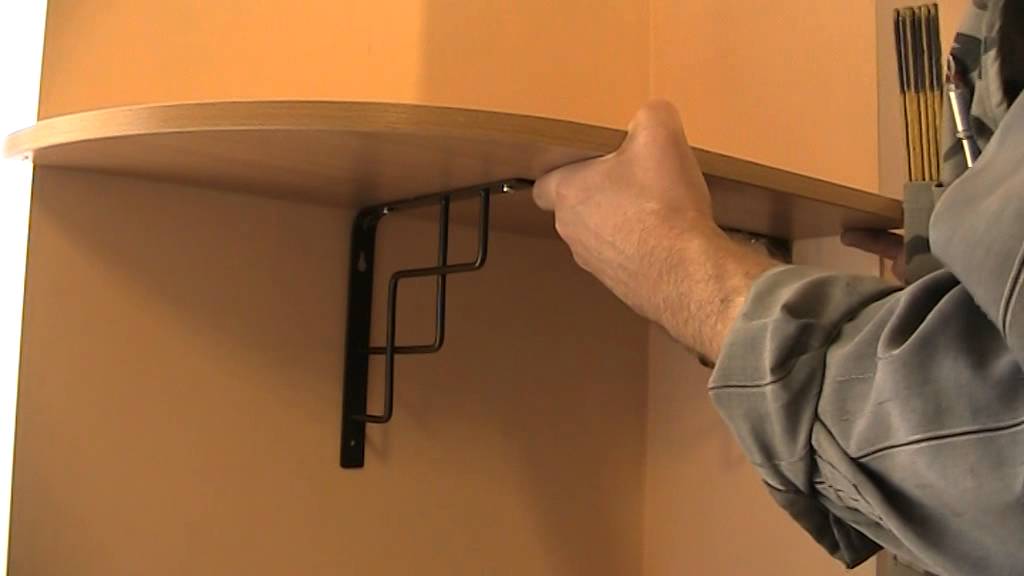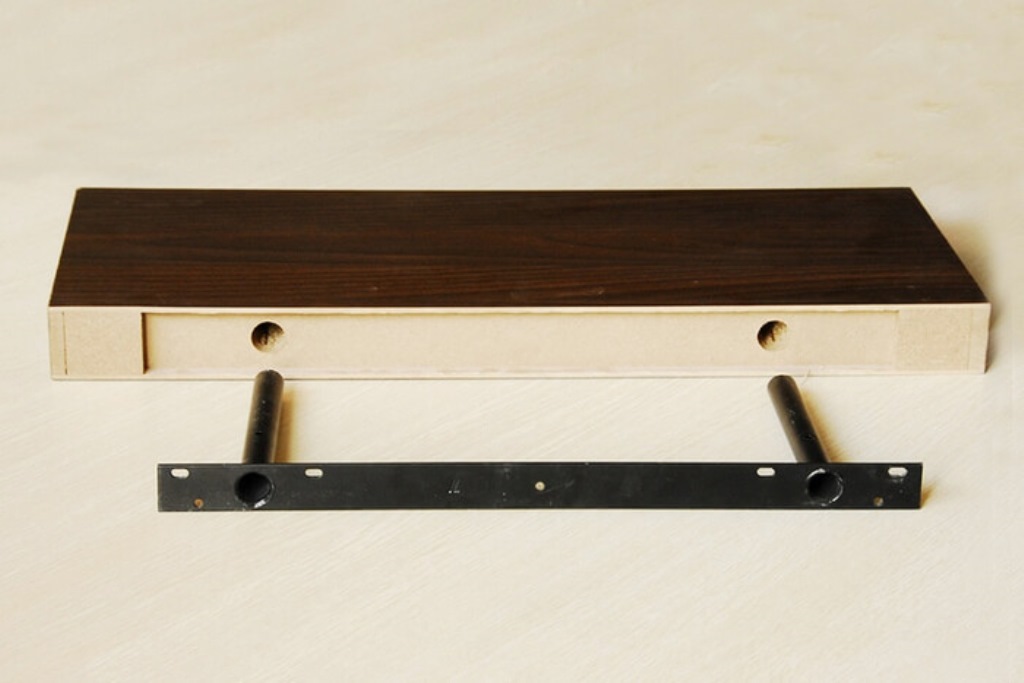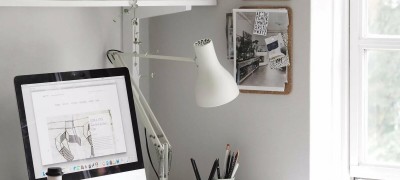How to properly attach the shelf to the wall
There is probably not a single modern house that does not have shelves. Despite the fact that this classic attribute of any interior has long become unnecessary, it still plays an important role in the design of premises. Despite the fact that sometimes it is just a necessary condition for organizing the workspace. Therefore, knowing how to hang a shelf on the wall will always come in handy. And not only in the household.

- Existing types of shelves
- How do I hang the shelf? Basic moments
- Is it possible to hang a shelf without fasteners
- The nuances of a hidden gimbal
- How to hang a shelf on a drywall wall
- How to hang a shelf on a concrete wall
- How to hang a heavy shelf on a wall
- What not to do
- Features of care and maintenance
- Video: how to hang a shelf so that it holds tight
- 50 options for design and arrangement of shelves in the interior
Existing types of shelves
Most of the shelves differ in the type of installation and design. With some stretch, you can add purpose and materials here.

Existing suspension types:
- Traditional. The most common type. The fastening system can be either visible or hidden. The very fact of attachment is at the forefront here.
- Hidden or hidden. In this case, the invisibility of the fasteners is a prerequisite.
- Outdoor installation. As a rule, these are various racks and their derivatives. Despite the similarity to a wardrobe, the rack still belongs to the shelves.

In terms of performance, most structures are designed based on the selected material. He also determines how to hang the shelf on a concrete wall or, for example, on a plasterboard lintel, how it will fit into the interior, as well as its functionality.

The material is usually used:
- Wood. The most commonly used: array, chipboard (chipboard), MDF.
- Metal. As a rule, a frame is made from it: welded or forged.
- Glass. Tempered matt or transparent.
- Plastic. It is rarely used. Mostly in the bathroom or kitchen.
- Items for various purposes. In this case, anything can serve as a shelf: an old suitcase, a hanger, an unnecessary wooden ladder, a book, or even a transport pallet.

How do I hang the shelf? Basic moments
Before proceeding, in fact, to the suspension, you need to decide on three important points:
- Estimated load.
- Mounting method.
- Purpose (functionality).

Actually, the load is the key parameter that determines everything else. The method of fastening and, under certain conditions, the place of installation depends on it.As for the purpose, it directly affects the location of the shelf and determines the ease of use: who will use it and how often. For example, in the nursery, it should be located lower than in the living room.

Preparatory work
In order to properly hang the shelf, the first step is to inspect the surface for the possibility of using the selected mounting method. In turn, the choice of fastening depends on the functional purpose and the load that the shelf will exert on the wall at the place of fixation. Thus, before proceeding with marking and drilling, you need to make sure that the wall material and fasteners are selected correctly (sometimes this can only be assessed after installation).

The next step should be to determine the footprints. For this, two methods are used: calculated and template. In the calculation method, the brackets or hinges must be fixed in advance - this will allow accurate measurements of the suspension points (holes or hinges) and transfer them to the wall using a ruler or tape measure. The template is simpler - the shelf, as it is, is attached to the wall and the attachment points are indicated after the fact.

Important! Before starting drilling, make sure that there are no electric cables, no water pipes or other communications laid in the selected area under the wall surface. Sometimes you have to use a special scanner-detector for this.
How to hang a shelf on the wall: the tools you need
It is clear that each type of work requires its own tools. However, in most cases it is advisable to have on hand:
- Electric impact drill. In principle, you can do with a hand drill, especially for materials such as foam concrete or drywall. But if you have to work with a concrete wall, you will need a puncher here.
- A set of drills and bits. It is never known in advance what will be faced (in terms of wall material), so it is always best to keep a spare drill with you for different types of surfaces.
- Level. Of course, sometimes they eliminate distortions and a glass of water, but with the help of a level it is more convenient to do this.
- Screwdriver. Its presence significantly speeds up the installation process. Although you can use screwdrivers.
- Little things. Pencil, ruler, core, hammer, electrical tape, etc.
Before you hang the shelf: safety precautions
When carrying out such work, it is extremely important to take the necessary precautions, since the risk of injury or injury to others is quite high. It is prohibited to start installation if:
- Work is carried out without gloves, goggles and a mask (to protect the respiratory system when preparing holes).
- The existing power tool has not passed a preliminary surface inspection for visible damage and a test switch.
- The wall was not inspected to determine the possible occurrence of electrical wiring below the surface.
- Usability is not properly ensured.

Is it possible to hang a shelf without fasteners
Most likely, you will not be able to do without fasteners, but to hide it is completely. In this case, several of the most common installation methods are used:
- On the brackets. The fasteners are selected in such a way that after the canopy, the shelf design hides it from view.
- With hidden hinges. The choice of this method is determined by the design features - the hinges should not protrude beyond the structural elements.
- Fitted with pins.An interesting solution that allows you to attach a product that consists of only one element - the load-bearing surface. In this case, the power element, a pin, is fixed directly in the body of the shelf.
- On glue. Installation is carried out by gluing the structure to the wall surface. This is rare due to a number of limitations.

The nuances of a hidden gimbal
So, how to hang a shelf without visible fasteners using conventional techniques will not work, there are a number of implicit points that must be taken into account in order for such a solution to be implemented:
- The nature of the surface, its structure and properties. It is better not to use this method for drywall walls or the like. As for brick or concrete walls, in the first case, their thickness should be at least 25 cm, in the second - more than 10 cm.
- Material thickness. A shelf on a hidden mount cannot be too thin, but it must also not exceed a certain thickness (about 6 cm) - this is due to the peculiarities of installation. This is usually 4.5 cm, although the acceptable minimum is 3 cm.
- The choice of fasteners. If installed on pins, their length should be two shelf widths and a diameter of at least 10 mm.
- Weight restrictions. For example, for a shelf with a width of 30 cm, a payload of no more than 15 kg is allowed.

How to hang a shelf on a drywall wall
Recently, this material has been offered so widely that manufacturers have begun to produce fasteners and entire systems specifically for it. Since drywall works extremely poorly for bending (kinking), conventional installation approaches are not suitable here.

As a rule, they use the following methods:
- Special fasteners. The shelf, which will not be heavily loaded, can be hung with special fasteners such as a molly screw or a butterfly.
- Creation of a power frame. In some cases, drywall sheets are installed on a special frame. The product is attached to it directly, however, for this you need to know the features of its design.
- Directly. If the sheets are a short distance from the main surface, the suspension can be carried out directly to the wall using anchors.

How to hang a shelf on a concrete wall
Concrete walls are great because they can support almost any weight. At the same time, the installation process of any design to them is very laborious. The most important difference from other cases is a prerequisite for using a hammer drill and special drills. Otherwise, the installation approaches remain the same.

In principle, you can stop at an impact drill, drill bits for concrete are also produced for it. Nevertheless, in practice, drills are rarely used, since their power is usually not enough to quickly prepare holes of the required depth and in the required quantity. As for drills, the most commonly used type is sprayed from pobedit.

How to hang a heavy shelf on a wall
Since the flange is a classic case of static loading, the only thing required is to match the total expected (design) weight and the bearing capacity of the surface. The latter will also determine the method of fastening. To do this, you should choose the right fasteners, based on the following criteria:
- Wall thickness and material.
- Estimated weight of the structure.
- The number of attachment points.

This can be either installation directly on the wall or the use of a supporting load-bearing frame, as well as, depending on the structure of the wall, the use of various options for fastening elements: wedge anchors, foam concrete dowels or so-called "chemical" dowels. Otherwise, the previously described process of how to hang a shelf on the wall does not differ in any significant way from this case.

What not to do
Unfortunately, most gimbal errors only appear over time. Therefore, it is important to know the rules for correct installation:
- Do not drill a hole equal to the length of the screw or anchor. It should be made a little longer.
- Do not use wedge or expansion anchors in aerated concrete or slotted brick walls.
- Avoid deviations of the longitudinal axis of the hole channel from the perpendicular to the wall surface.
- Carry out the installation of structures to drywall directly, without special fasteners.
- Fasten heavy items not to load-bearing (main) walls.
- Use fasteners that are not suitable for the suspension conditions.

Features of care and maintenance
In general, if you hang the shelf correctly, it requires only normal care, the nature of which is determined by the material used: regular cleaning from dust, exclusion of direct sunlight and moisture (especially for chipboard products), careful handling in everyday life.

Here, more attention should be paid to fasteners and suspension points. Depending on the degree of load and the intensity of operation, it is advisable to inspect the attachment points once a quarter or six months. In case of sagging, an increase in the gap between the rear wall and the mounting surface, immediately take measures to eliminate them. Otherwise, over time, the shelf may fall.

The ability to independently equip your living space has become even more relevant with the emergence of the widest range of available materials, fixtures, as well as ideas and possible solutions. Therefore, the knowledge of how to hang a shelf on the wall provides that level of independence that will allow you to organize your life, your space the way you want, and not the way it turns out.
Video: how to hang a shelf so that it holds tight



























































